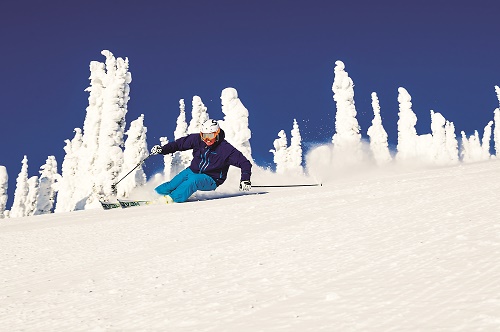Good ole January in the Pacific Northwest. The snow coverage is usually great in the mountains, and the resorts are almost always in full-swing operations. Some might say it’s the perfect time of year to hit the slopes. But is mid-winter really all it’s cracked up to be? Others counter that it has a reputation for being a time of year seasoned skiers and riders have come to dislike.
It’s not always a lock, but the mid-winter months can occasionally bring with them a brief seasonal front brought on by an atmospheric high-pressure system that has drifted in from the Pacific. The resulting weather is usually a combination of warmer than average temps combined with little or no snow accumulation that can linger for weeks, creating what some consider to be less than desirable ski conditions – “same sh!#, different day,” as groaned by the local snow-snobs.
Jumping online for the conditions du jour, you’re bound to read the industry standard phrase ‘packed-powder’ somewhere in the snow report. For me personally, this has always been a confusing term as the phrase packed-powder is somewhat of an oxymoron given that the light, fluffy snow that I know to be powder resembles nothing that I would call packed. It’s akin to describing water as being dry. I can’t say I blame them though, as calling it packed powder easily sounds more alluring than what I might call it – firm, skier/groomer-packed snow. But I digress.
Does this firm, skier/groomer-packed snow really deserve the bad rap that some have given it? Are people too quick to dismiss the idea of driving to the mountains if they don’t see new snow accumulation? I believe that these occasional dry spells can provide some of the best opportunities of the season. Here’s why.
When Mother Nature has gone on strike, the groomers really are your best option, unless, of course, you enjoy hacking your way through the funky, reconsolidated snow that lives in the trees. But the groomer days don’t bother me at all because they offer something that’s unique: the wide open space and freedom to completely shake loose, open up the throttle, and feel the thrill of carving high-speed turns.

The secret to happiness is perspective, and that’s particularly true when skiing. Firm snow skiing and riding can be crazy, rad fun; it’s just a different type of skiing and riding than what many of the core folks tend to lust after. Groomed, or firm snow carving doesn’t always get the love it deserves from the ski magazines or fat ski manufacturers that would have you believe that anything other than epic, knee-deep powder days are a complete bore. Don’t get me wrong, powder is, and always will be the sexy choice, but a fast and furious day on the corduroy can provide a completely different type of thrill that’s not possible on a deep day.
Starting from the top, the exhilaration quickly builds with each small turn driving you closer to the heart of the run. Building to a larger turn shape, you’re railing on the ski’s edge through the belly of each turn, gaining more speed and momentum with each pass. Shooting like a rocket in and out of the turns, you’re barely hanging on as you push the line between control and chaos. Experiencing the ski bend, react and load under your foot while pushing serious gees on a wide open plane might be one the greatest feelings you can ever know.
Unfortunately, a lot of people dread these firm snow days because they never learned how to properly engage their edges. They spend their entire day linking death-skids until they can no longer stand the horrific scraping sensation anymore and finally pack it in. There’s nothing exhilarating about skidding like a windshield wiper, regardless of the snow conditions. To really experience the firm snow magic, you’ve got to get your skis on edge and make them carve (this is why they are shaped). Carving is an important skill that will help you maintain control, preserve your speed and momentum through the turn and keep you smiling especially when the snow firms up.
I still love watching hard-plate snowboarders carve big, powerful arcs as they descend an open run. When it’s done right, it’s absolutely beautiful. Europeans, who have access to arguably the most extreme off-piste skiing in the world, still have a ton of reverence for what happens on-piste. As a culture that seems to place emphasis on beauty over strength, they appreciate the gracefulness and dedication to form that is required to make perfect turns come together. I’ve worked in both American and French ski schools, and I can tell you that the French are much less interested in efficiency as they are the aesthetic.
This season, try looking at those mid-winter dry-spells in a different light. Revel in the firm snow exhilaration that only the “roy” can bring. But you won’t have long though, as there’s almost always serious storm activity brewing up for February’s weather models. //













